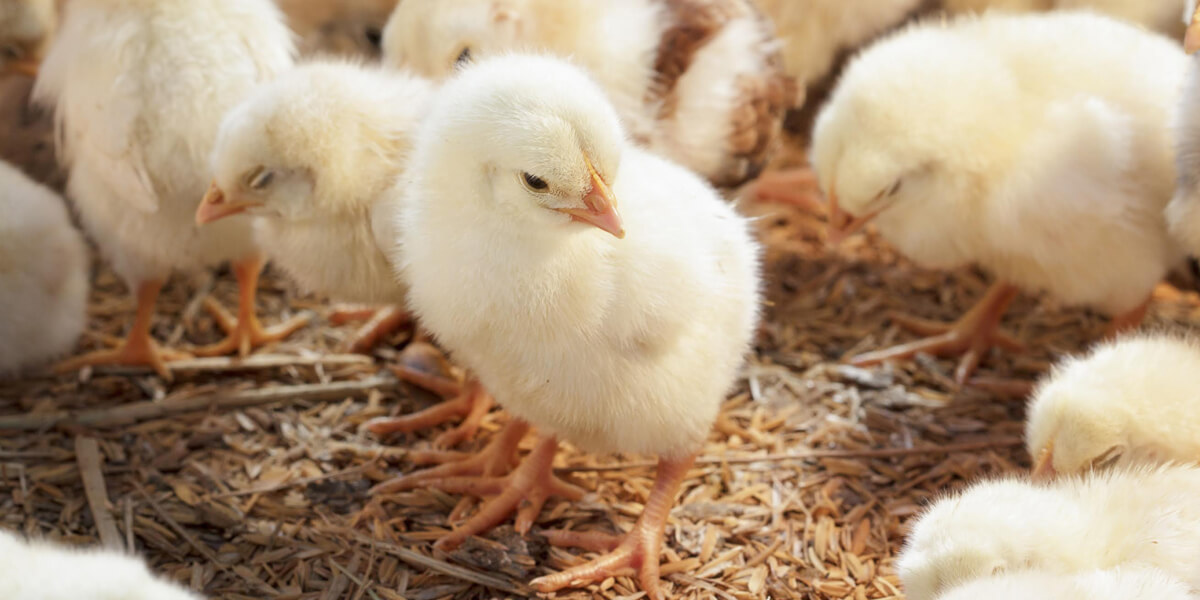Footpad dermatitis is a common issue in poultry production with average prevalence rates often hovering around 20%, but sometimes reaching as high as 100% on some poultry operations.
Footpad dermatitis is characterized as the loss of integrity in the skin of the footpad of a bird. It starts as a chemical – mechanical challenge, often due to wet litter conditions with high pH levels and can later become an infectious challenge. When the footpad becomes damaged, it can open a scar, which can then be contaminated with bacteria, leading to secondary infection, triggering an inflammatory response.
It’s important to manage footpad dermatitis, especially when birds are young, as their immune systems and the keratin layer on their footpads are not fully developed and it will take longer for the lesions to heal. In some cases, the lesions may never fully heal.
Wet Litter Conditions Cause Footpad Dermatitis in Poultry
The biggest cause of footpad dermatitis in poultry is ammonia in the litter. Wet litter conditions can increase the production of ammonia, which can create a micro-environment of around 11 pH in direct contact with the feet. Litter is naturally humid, but there are other factors that can increase ammonia production and contribute to footpad dermatitis.
- Poultry nutrition programs that are high in protein contribute to an increase in the excretion of nitrogen, which will later become ammonia in the litter.
- High sodium diets or high levels of electrolytes can also lead to wet litter and thus higher production of ammonia.
- High stocking densities can contribute to wet litter and increase ammonia too.
- Other external factors that can cause footpad dermatitis include leaky drinkers or poor ventilation that does not create enough airflow to keep litter dry.
Visual Signs of Footpad Dermatitis in Poultry
When footpad dermatitis is severe, birds will be reluctant to move due to the pain. In other cases, you may have to lift the birds and examine their feet. If they have footpad dermatitis, you will see a scar resembling a dry, brown and black scab on the skin. Swelling in the feet is also common.
The severity of footpad dermatitis can be determined by using a footpad dermatitis lesion scoring system. Footpad dermatitis lesion scoring systems vary throughout the world, but the scale used in the United States is a 4-tier system:
- 0 – Normal, no lesion
- 1 – Mild lesion
- 2 – Moderate lesion
- 3 – Severe lesion
Animal welfare inspections include similar criteria.
Footpad Dermatitis Affects Wellness and Performance in Poultry
Footpad dermatitis may start with just mild pain for a bird, but as the lesion becomes more severe and bacteria penetrate the skin and cause secondary infection, the bird’s pain can increase. This will lead to birds being reluctant to move, ultimately reducing feed and water intake.
Research studies show that as the severity of footpad dermatitis increases, the feed conversion rate becomes worse. Birds that are in more pain due to footpad dermatitis — or dealing with a secondary infection — will expend more energy and nutrients to fuel an inflammatory response to the fight the infection and heal the lesion. This leaves fewer nutrients and less energy available for the bird to use for growth and development. This condition is also considered an important indicator of welfare.
Footpad Dermatitis in Poultry Impacts Chicken Feet Export Industry
In the United States, chicken feet are usually considered a byproduct, but in Asian countries, they are a very valuable delicacy.
For a chicken foot to be suitable for export, it must be completely clean and free of any footpad dermatitis lesions beneath the keratin. Even footpads with just mild or moderate lesions will not be acceptable for export.
If a bird has previously had footpad dermatitis and the lesion has completely healed, their feet may still be acceptable for export. Also, footpads that have lesions on the keratin layer, but are clean once that keratin cover has been removed, are okay as well. This is why preventing footpad dermatitis is important from an early age and onward.
Performance Trace Minerals to Manage Footpad Dermatitis
Skin cells (keratinocytes) have a high demand for nutrients due to their high turnover rate. Poultry diets normally provide adequate levels of vitamin A and biotin, both of which are important for the skin. Zinc, a fundamental nutrient for skin integrity and healing, however, is frequently missing since it is not easily absorbed and requires a high-quality source.
Supplementing your poultry nutrition program with 40 ppm of zinc from Zinpro® Availa® Zn can increase keratin production and reduce the impact of footpad dermatitis on your flock.
In one study, performance trace minerals reduced the severity of footpad dermatitis lesions from an average score of 2.1 to 0.9 in birds exposed to wet litter. This increased the number of footpad acceptable for export by 30%.
Proper Litter Management for Controlling Footpad Dermatitis in Poultry
The best way to manage footpad dermatitis is through successful litter management. Pay special attention to the condition of your litter during the first three weeks of your flock’s life as they develop keratin and a resistance to footpad dermatitis.
Litter should be clean and dry with a thickness of at least 2–3 inches to adequately absorb humidity. You should also use a material that is better able to absorb humidity, like hay or wood shavings as opposed to rice hulls. Monitor your litter and make sure you are replacing the material when it gets too wet and cannot absorb humidity.
Be sure your poultry house has adequate ventilation to maintain dry litter. Also, keep drinkers in good condition and make sure they are not leaking and contributing to wet litter. Flush and clean them thoroughly before a flock comes into the house. Make sure they are all sealing properly and that the water pressure is not too high.
Contact your Zinpro representative today to learn more about supplementing your poultry nutrition program with Availa-Zn.

